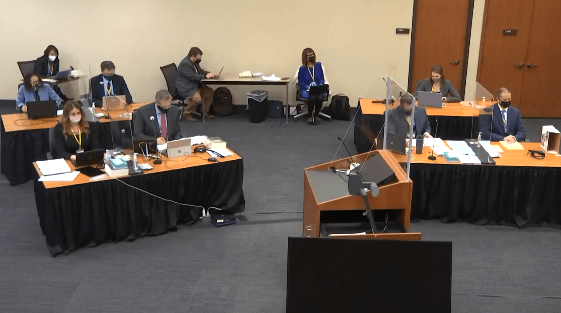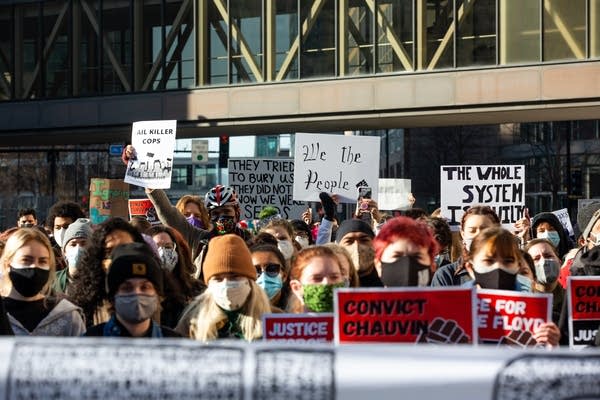Chauvin trial: Floyd DNA on meth-fentanyl pill found in police squad

Go Deeper.
Create an account or log in to save stories.
Like this?
Thanks for liking this story! We have added it to a list of your favorite stories.
MPR News is streaming live coverage of the trial. Some images or material discussed during the trial will be disturbing to many viewers. Watch Wednesday’s court proceedings here.
3 things to know:
Officials: Pill in squad car held meth and fentanyl, had Floyd’s DNA; Floyd’s blood also found in stains
Derek Chauvin’s force on Floyd included “pain compliance” technique, expert testifies
Case expected to hinge on responsibility for Floyd’s death; defense points to Floyd’s health conditions, drugs; prosecution points to Chauvin’s actions
Updated 7:52 p.m.
Pills found during the forensic investigation into George Floyd’s death in police custody tested positive for methamphetamine and fentanyl; one contained Floyd’s saliva, officials testified Wednesday during the murder trial of ex-Minneapolis police officer Derek Chauvin.
Pills were found in the SUV Floyd was driving; one that contained DNA from Floyd’s saliva was also found in the back of the police squad vehicle that briefly held Floyd.
The presence of the drugs wasn’t a surprise, since the medical examiner’s report on Floyd showed the presence of drugs in his system.
Turn Up Your Support
MPR News helps you turn down the noise and build shared understanding. Turn up your support for this public resource and keep trusted journalism accessible to all.
The defense has argued that Floyd died due to underlying medical conditions or drugs in his system, and not due to Chauvin's knee on his neck or the other two officers also holding him down with their body weight, which is what prosecutors are arguing.
Experts with the Minnesota Bureau of Criminal Apprehension told jurors that several bloodstains were also found in the vehicle that testing later confirmed were Floyd’s.
Chauvin, who was fired from the force, faces murder and manslaughter charges in Floyd’s May 25 killing while in police custody. Bystander video showed Chauvin with his knee pressed against Floyd’s neck for more than nine minutes as the man lay handcuffed and face down on the pavement, pleading that he couldn’t breathe.
James Reyerson, the Minnesota Bureau of Criminal Apprehension agent in charge of the investigation, was asked Wednesday by prosecutor Matthew Frank about when Floyd stopped moving.
“Does it appear that Mr. Chauvin is using his legs to hold Mr. Floyd down?" Frank asked Reyerson, who replied, “Yes, it does.”
While Chauvin restrained Floyd on the ground for a total of 9 minutes and 29 seconds, Reyerson testified in court that Floyd was not responsive for more than four minutes before paramedics arrived.
Reyerson outlined the extent of the criminal investigation during his testimony, which he said involved interviews with about 200 citizen witnesses, as well as assistance from about two dozen Federal Bureau of Investigation agents.
'At that point, it’s just pain’
Wednesday began with a prosecution use-of-force expert concluding that Chauvin's restraint of Floyd constituted an unwarranted use of deadly force.
Jody Stiger, a prosecution witness, noted that Floyd's subdued position — handcuffed, prone and pinned face down on the street — created the danger of positional asphyxia even without the pressure of Chauvin's knee on Floyd's neck. Adding the body weight increased the likelihood of death, he added.
Stiger also said his analysis of video and images of Chauvin's restraint on Floyd showed Chauvin grasping the fingers of Floyd's left hand in what appeared to be a "pain compliance" maneuver.
"Pain compliance is a technique that officers use to get a subject to comply with their commands. As they comply, they are rewarded with a reduction in their pain," Stiger explained.
What if there's no opportunity for compliance, the prosecution asked. Stiger responded: "Then at that point, it's just pain."
During his testimony, the prosecution dissected a few still frames from videos that captured the incident in an attempt to counter the defense's argument that Chauvin's knee was on Floyd's shoulder blade instead of his neck. The defense brought that up Tuesday.
But in the photos presented, Stiger said Chauvin appears to be using his body weight and knee to push down on Floyd's neck.
Under cross-examination by defense attorney Eric Nelson, Stiger agreed that objective reasonable use of force standards can differ by police departments, although all follow state and federal law. But Nelson couldn't get Stiger to agree on every point specific to this case, including whether a handcuffed person can still pose a threat.
"And sometimes the use of force is instantaneous?" asked Nelson.
"Sometimes, but not in this case," Stiger replied.
Nelson presented training material and they agreed that neck restraints are commonly used by law enforcement officers. Nelson also noted that suspects who are rendered unconscious can sometimes come back more aggressive. And he pointed to different video and still images that showed Chauvin's exact knee placement differs depending on the angle.
Nelson returned to a common theme of his defense — that police use of force is rarely "attractive."
But when Schleicher had an opportunity to question the expert witness again, Stiger reiterated his main point that Chauvin's use of force was excessive based on the totality of circumstances.
The expert also said the bystanders filming and calling out their concerns about Floyd's condition at the scene were not a threat and that officers can only use force based on the actions of the person they're trying to subdue, not the reaction of the crowd.
The defense has suggested during the trial that the tension between the officers and the bystanders kept the officers from attending to Floyd's distress.
Stiger said Chauvin's experience — he was a 19-year veteran of the force with hundreds of hours of training — should have been sufficient to prepare for this distraction.
Any amount of force against Floyd was inappropriate, given the man’s alleged offense, buying cigarettes with a counterfeit $20 bill, Stiger said in earlier testimony.
Trial basics

Who’s who: A look at the key players in the trial.
Need to know: Key questions about the trial, answered.
What we know about the jurors: The 12 jurors and two alternates picked to review the case include a chemist, a youth volunteer, a cardiac nurse and an IT professional.
Chauvin's lawyer is outnumbered, but has help: No fewer than four attorneys have appeared for the prosecution so far, compared to a single attorney to defend Derek Chauvin.
Legion of Chauvin prosecutors, each with own role: Viewers may be struck by the array of prosecutors taking turns presenting their case. The choice of who does what is no accident.
MPR News on its coverage: Nancy Lebens, the newsroom’s deputy managing editor, answered audience questions about our reporting plans.
George Floyd and his legacy

Remembering George Floyd, the man: Before he became a symbol in the fight for racial justice, friends say Floyd was a “gentle giant” who sought a fresh start.
Making George Floyd Square: Here’s how the site of Floyd’s killing — 38th Street and Chicago Avenue in Minneapolis — is being reshaped.
Rescuing the plywood — and memorializing a movement: Two Black women are leading the effort to preserve the murals painted on storefront boards in the Twin Cities.
Calls for change: Here’s what some Floyd activists tell MPR News about their experiences with race in Minnesota, why they march and what they hope for the future.
Read more

Trial breaks 'blue wall of silence,' but will it transform policing? "My hope is that it leads to results in terms of transforming the way that policing happened in Minneapolis," said civil rights attorney and activist Nekima Levy Armstrong. (NPR)
What is excited delirium? Derek Chauvin's attorney has raised the concept of excited delirium as testimony examines whether reasonable force was used on George Floyd. (The Associated Press)
Is defense blaming acquaintance in Floyd's death? The defense clearly thinks Morries Hall can help them raise doubt in the minds of jurors about how George Floyd died. (The Associated Press)
How long did it take medics to reach Floyd? Last week, the defense questioned paramedics in their efforts to resuscitate George Floyd, and seemed to suggest a drawn-out response, potentially setting up an argument that if medical help had arrived sooner, Floyd could have been saved. (The Associated Press)
Floyd's family takes its seat in ex-officer's murder trial: A member of George Floyd's family often occupies a reserved seat in the back corner of the courtroom. (The Associated Press)
Racism is making us sick. How can equity in medicine help us heal? Two doctors and a medical researcher talk about how racism affects their patients’ health — and how racism in medicine leads to inadequate medical education and poor care. (Sahan Journal)
Was officer's knee on Floyd's neck authorized?: Here is a look at the Minneapolis Police Department’s policy, and how it could factor into a verdict for ex-cop Derek Chauvin. (The Associated Press.)
NPR’s live blog: The latest from the murder trial of Derek Chauvin.


